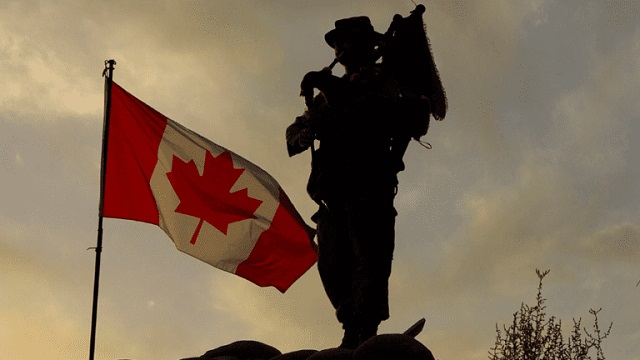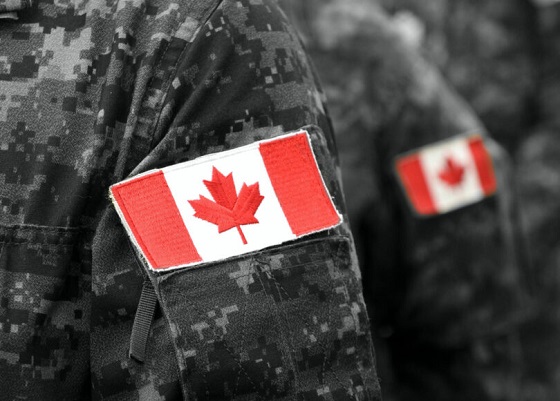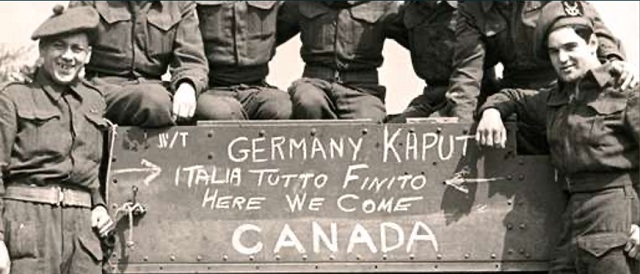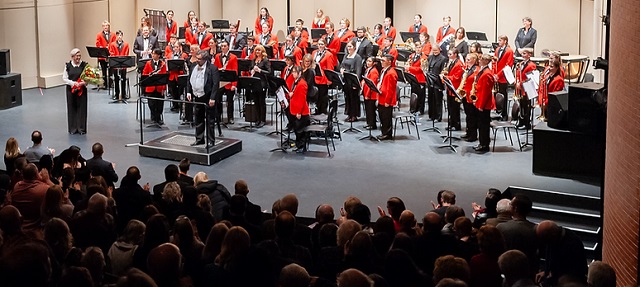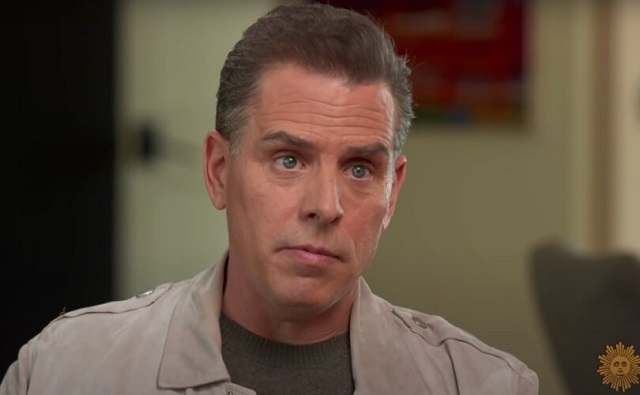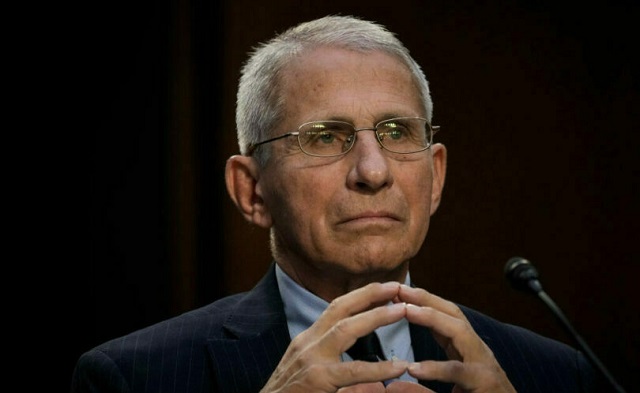Their force was huge; approximately eight Allied divisions including paratroopers were due to challenge Nazi Germany’s mastery of the French coast in one mass landing that would start at the water’s edge and was aimed at reaching the heart of Berlin to end the Second World War. American divisions had been assigned to beaches code-named Utah and Omaha. British divisions would land at Sword and Gold Beaches. Paratroopers from the U.S., Britain and Canada would touch down at the left and right flanks of the landing beaches to secure those beaches from German attack.
 The plan to land a huge force in Normandy, France into the teeth of well-prepared Nazi defences would be the largest seaborne invasion in history – and the Western Allies’ riskiest large-scale operation of the Second World War. Failure would have meant tens of thousands of dead and extended the war by years. Orville Fisher was attached to the Canadian 3rd Infantry Division, the only combat artist to come ashore with the Allied assault troops on D-Day, sketching scenes that later became his paintings.
The plan to land a huge force in Normandy, France into the teeth of well-prepared Nazi defences would be the largest seaborne invasion in history – and the Western Allies’ riskiest large-scale operation of the Second World War. Failure would have meant tens of thousands of dead and extended the war by years. Orville Fisher was attached to the Canadian 3rd Infantry Division, the only combat artist to come ashore with the Allied assault troops on D-Day, sketching scenes that later became his paintings.
One of the units readying for the landing was the Third Canadian Infantry Division, consisting of about 20,000 men. Commanded by Maj.-Gen. Rodney F.L. Keller, the Third was assigned its very own beach, codename: Juno (which the local inhabitants knew as the villages of Courseulles, Bernières and Saint-Aubin). Meanwhile the First Canadian Parachute Battalion was destined for the eastern flank of the landing beaches as part of the First British Airborne Army.
In the skies over the beaches, Royal Canadian Air Force (RCAF) No. 6 Group’s heavy four-engined Lancaster bombers were in the air before dawn, flying toward the beaches and aiming to destroy German defensive fortifications built just beyond the high tide line. Bunkers, machine gun positions and so-called “pill boxes” were all targets the bombers were hoping to take out to make the infantry soldiers’ landing and exposed scramble up the beach just a little bit easier. For the most part this bombing by British, Canadian and American heavies turned out to be useless, however. Great holes were blasted in the sand or inland from the beaches, but very few fortifications were disabled.
 Canada was to play an important role in Operation Overlord, with the 3rd Canadian Infantry Division assigned its own beach – codenamed “Juno”. Delayed by rough weather in the English Channel, D-Day ended up occurring on June 6, 1944, the first – and crucial – step in the liberation of Western Europe from Nazi Germany. (Source of map: Juno Beach)
Canada was to play an important role in Operation Overlord, with the 3rd Canadian Infantry Division assigned its own beach – codenamed “Juno”. Delayed by rough weather in the English Channel, D-Day ended up occurring on June 6, 1944, the first – and crucial – step in the liberation of Western Europe from Nazi Germany. (Source of map: Juno Beach)
Also in the air, British, American and Canadian fighter bombers – Spitfires and Typhoons of the RAF’s No. 83 Group – too headed for the beaches. They and the United States Army Air Force’s Thunderbolts and medium bombers were tasked with providing close air support for the assaulting troops. Canadian DC-3 Dakota transports were in the air ferrying Canadian and other paratroopers to their designated landing zones – where they would drop many of them all over the Normandy peninsula.
At sea, corvettes, frigates and destroyers of the Royal Canadian Navy helped guard the seaward flanks of the landing against attacks by German submarines or fast attack boats, while in the waters facing the landing beaches, Canadian naval vessels joined with British and American ships to escort the transports and the landing craft to the beaches, braving German onshore artillery batteries and subject to the thunderous booms made by the huge naval guns of British and American cruisers and battleships that were aiming to destroy German defences.
The Canadian soldiers, sailors and airmen were there because they were needed to fill the ranks of this great landing force to ensure victory at the water’s edge, so that the long march to Berlin could begin. They were as vital a part of the D-Day landings as were their British and American counterparts.
In this greatest military landing in history, some 30,000 Canadian soldiers, sailors and airmen took part and provided about one-fifth of the entire force hitting the Normandy beaches that day. They were not there to provide a token Canadian presence. They were not there to soothe the collective egos of Canada’s citizenry (numbering about 11 million at the time). Nor were they there to allow the Canadian government of William Lyon Mackenzie King to puff out its collective chest in a display of Canadian pride.
The Canadian soldiers, sailors and airmen were there because they were needed to fill the ranks of this great landing force to ensure victory at the water’s edge, so that the long march to Berlin could begin. They were as vital a part of the D-Day landings as were their British and American counterparts. Canada was not included out of some Allied feeling of pity; it was included because its army, navy and air force were vital for victory.
 Vital for victory: Canada’s contribution of some 30,000 soldiers represented one-fifth of the entire Allied invasion force. Depicted: top, aerial view of Juno Beach on the morning of D-Day showing landing craft coming ashore; middle left, 9th Canadian Infantry Brigade landing at Bernières-sur-Mer; middle right, the Royal Winnipeg Rifles heading towards Juno aboard Landing Craft Assault; bottom left, Royal Canadian Navy frigate HMCS Wakesiu, which helped guard the landing fleet; bottom right, Royal Canadian Air Force (RCAF) Supermarine Spitfire F Mk. VI. (Sources of photos: (top) Warfare History Network; (middle left) Department of National Defence (DND)/National Archives of Canada photos; (middle right) Library and Archives Canada; (bottom left) Library and Archives Canada Photo, MIKAN No. 3583160; (bottom right) Library and Archives Canada Photo, MIKAN No. 3583160)
Vital for victory: Canada’s contribution of some 30,000 soldiers represented one-fifth of the entire Allied invasion force. Depicted: top, aerial view of Juno Beach on the morning of D-Day showing landing craft coming ashore; middle left, 9th Canadian Infantry Brigade landing at Bernières-sur-Mer; middle right, the Royal Winnipeg Rifles heading towards Juno aboard Landing Craft Assault; bottom left, Royal Canadian Navy frigate HMCS Wakesiu, which helped guard the landing fleet; bottom right, Royal Canadian Air Force (RCAF) Supermarine Spitfire F Mk. VI. (Sources of photos: (top) Warfare History Network; (middle left) Department of National Defence (DND)/National Archives of Canada photos; (middle right) Library and Archives Canada; (bottom left) Library and Archives Canada Photo, MIKAN No. 3583160; (bottom right) Library and Archives Canada Photo, MIKAN No. 3583160)
By June 1944 Canada had built a miraculous military out of what was virtually nothing when it declared war on Germany on September 10, 1939. At that time Canada possessed one understrength infantry brigade consisting of three regular force and six reserve battalions. The regular force battalions were full-time soldiers of about 300 men each who had to be brought up to a strength of about 820 men before they reached war establishment strength. The reserve battalions were part-time soldiers who had regular civilian jobs but spent an evening or two each week training at a local armoury and a few weeks each summer at an encampment with other reserve soldiers training for war. Canada also had a regular force artillery regiment and an armoured regiment that had no real tanks.
It was, in other words, an army living almost entirely on paper and in the minds of its small number of dedicated officers and soldiers.
The Royal Canadian Air Force (RCAF) in 1939 was even worse off, with just a single modern fighter squadron consisting of British-designed Hurricane fighters built at the Canadian Car and Foundry factory at Fort William, Ontario. Other aircraft were either completely obsolete or consisted of civilian types used for government missions inside Canada. Despite wide-open spaces and clear skies in winter in the frigid Canadian West, aircrew training had been minimal. Almost no-one in the RCAF wrote about or discussed aerial tactics or campaign strategy since everyone assumed that the RCAF would be taken under the wing of Britain’s Royal Air Force in case of international emergency.
 Decrepit beginning: Like the army and navy, the RCAF entered the war small and ill-equipped, with obsolete aircraft like the Wapiti bomber (top) plus barely a dozen somewhat-modern Hawker Hurricanes (bottom). (Sources of photos: (top) Library and Archives Canada; (bottom) CANAV Books Collection)
Decrepit beginning: Like the army and navy, the RCAF entered the war small and ill-equipped, with obsolete aircraft like the Wapiti bomber (top) plus barely a dozen somewhat-modern Hawker Hurricanes (bottom). (Sources of photos: (top) Library and Archives Canada; (bottom) CANAV Books Collection)
That was also true of the Royal Canadian Navy, which consisted of seven modern destroyers and a number of smaller craft, but which was concentrated on Canada’s West Coast in the event of a war against Japan, which was considered the most likely danger for Canada. The Royal Canadian Naval Reserve numbered fewer than 1,000 personnel, mostly seamen who held harbour jobs such as captaining tugboats or salvage vessels, or northern supply ships. But they, at least, knew what salty air smelled like and how to stand on the deck of a moving ship.
Canada had not even begun to prepare for hostilities until sometime around 1937. That was largely because the governments of Conservative R.B. Bennett (1930-1935) and Liberal Mackenzie King (returned to office in 1935) feared the political earthquake they assumed would take place if Quebeckers came to suspect that Canada was contemplating the reintroduction of conscription that had torn English-speaking and French-speaking Canadians apart in the last two years of the First World War.
 Canadian Prime Minister William Lyon Mackenzie King (left) was so sure another major European land war was impossible (while being terrified of the domestic political implications of rearmament) that it took him two years to read General A.G.L. McNaughton’s (right) 1935 memo about the Canadian military’s catastrophic state. (Sources of photos: (left) National Archives of Canada, C-042725; (right) Library and Archives Canada, PA-034104)
Canadian Prime Minister William Lyon Mackenzie King (left) was so sure another major European land war was impossible (while being terrified of the domestic political implications of rearmament) that it took him two years to read General A.G.L. McNaughton’s (right) 1935 memo about the Canadian military’s catastrophic state. (Sources of photos: (left) National Archives of Canada, C-042725; (right) Library and Archives Canada, PA-034104)
It was expected that any serious effort to begin preparing Canada as a result of the rise of Nazism in Europe, the Japanese assault on China or the civil war in Spain might tear the country asunder once again. Only in 1937 did King finally get around to reading a detailed memo from General A.G.L. “Andy” McNaughton, who had retired as Chief of the General Staff in 1935 and moved on to lead the National Research Council, and it was only then that the prime minister finally understood how weak Canada’s defences were. But even then the expansion of the army, navy and air force went ahead very slowly. King simply did not believe another major land war in Europe would ever take place.
Canada’s declaration of war against Germany on September 10, nine days after Hitler’s surprise invasion of Poland, did not move mountains in Canada’s rearmament effort. Regarding the air, Canada signed an agreement with Great Britain, Australia and New Zealand to establish a training plan for the large numbers of aircrew who would be needed, called the British Commonwealth Air Training Plan or BCATP. Using mostly civilian flying clubs to begin with, it steadily spread across the country and proved one of the Canadian war effort’s signal successes, eventually turning out nearly half of all the aircrew who manned the air forces of Great Britain, Canada, Australia and New Zealand – plus thousands from the U.S. and countries that had been conquered by the Nazis, like Greece and Norway – some 130,000 personnel in all.
The Navy, meanwhile, sent its West Coast destroyers through the Panama Canal and onward to the North Atlantic to begin escorting merchant ship convoys from Halifax and St. John to the United Kingdom (and, later, Murmansk in the Soviet Union). The RCAF’s only “modern” fighter squadron of already-aging and not-fit-for combat Hurricanes was sent to the UK as No. 1 Fighter Squadron, along with an army cooperation squadron. And the First Canadian Infantry Division, now fully manned, was sent to the UK in December 1939 consisting of three brigades, each with a single regular force battalion and two reserve battalions.
For a full year – from June 1940 to June 1941, when the Nazis invaded the USSR – numerically little Canada was Britain’s most important ally.
Overall, during the Second World War’s first nine months Canadian mobilization went rather slowly. The King government – still anxious to avoid any mention of conscription – chose to fight a “limited liability war” sending only token fighting forces to the UK but mobilizing natural resources such as food, lumber and metal ores to help the UK economy and war effort. Having believed there would never be another major war, King and his cabinet now believed that the numerically large French army, together with an expanding British Expeditionary Force, would be more than enough to hold off the Nazis in Western Europe.
Until suddenly they weren’t when the Germans, having quickly conquered Poland in the fall of 1939, attacked westward in May and forced the surrender of France on June 22, 1940. That was when Canada realized the great danger it was in: when it seemed Britain itself was on the verge of surrender. Limited liability was flushed down the drain, huge increases in defence spending followed along with a massive mobilization aimed at the creation of an entire Canadian army, a navy capable of escorting thousands of cargo ships across the Atlantic and a multi-purpose air force to back the British fight against Hitler. For a full year – from June 1940 to June 1941, when the Nazis invaded the USSR – numerically little Canada was Britain’s most important ally.
 Aerodrome of democracy: The British Commonwealth Air Training Plan (BCATP), formed by the UK, Canada, Australia and New Zealand, became one of the signal successes of Canada’s war effort, with Canada undertaking its largest-ever construction program and turning out 130,000 aircrew from the Allied countries around the world. Depicted: top left, Lord Riverdale (seated on the left) and Mackenzie King (seated on the right) signing the BCATP Agreement on December 17, 1939; top right, No. 19 Elementary Flying Training School at RCAF Virden, Manitoba, 1944; bottom left, airplane engine mechanic candidates work at the Technical Training School in St. Thomas, Ontario, 1940; (bottom right) Royal Australian Air Force pilots at No. 2 Service Flying Training School RCAF Uplands, Ontario, 1940. (Sources of photos: (top left) National Archives of Canada, C-016761; (top right and bottom right) DND Archives; (bottom left) DND Archives, PL-1035)
Aerodrome of democracy: The British Commonwealth Air Training Plan (BCATP), formed by the UK, Canada, Australia and New Zealand, became one of the signal successes of Canada’s war effort, with Canada undertaking its largest-ever construction program and turning out 130,000 aircrew from the Allied countries around the world. Depicted: top left, Lord Riverdale (seated on the left) and Mackenzie King (seated on the right) signing the BCATP Agreement on December 17, 1939; top right, No. 19 Elementary Flying Training School at RCAF Virden, Manitoba, 1944; bottom left, airplane engine mechanic candidates work at the Technical Training School in St. Thomas, Ontario, 1940; (bottom right) Royal Australian Air Force pilots at No. 2 Service Flying Training School RCAF Uplands, Ontario, 1940. (Sources of photos: (top left) National Archives of Canada, C-016761; (top right and bottom right) DND Archives; (bottom left) DND Archives, PL-1035)
Two key moves that the King government undertook after the fall of France were to negotiate a bi-national agreement with the U.S. for the shared defence of North America and to introduce a National Resources Mobilization Act which gave the federal government exclusive power to manage the wartime economy – including conscription of manpower (though only for domestic defence purposes). In early 1941 the two countries also signed an agreement to share war production.
In just a few weeks after the Fall of France Canada’s economy, society, government and armed forces shifted to an all-out war effort. Almost all Canadians threw their support behind it, agreeing to strict rationing of just about every civilian commodity from canned fruit to gasoline, buying war bonds to lend the government money, and pouring into the armed forces. Second World War Canada was a very pro-British country. Although most English-speaking Canadians had been born in Canada, their roots were firmly planted in the UK. A royal tour in the summer of 1939 had brought out large crowds to cheer King George VI and queen consort Elizabeth. Even in mostly French-speaking Quebec, the couple received a rapturous welcome.
 All-out war effort: The National Resources Mobilization Act of 1941 focused Canada and Canadians on pouring their nation’s resources into the armed forces, making sacrifices not only at the frontlines but also at home. Depicted: top, the Algonquin Regiment shown leaving Port Arthur, Ontario, 1941; bottom left, production line of a Ram tank; bottom right, children taking rubber tires and shoes to a salvage centre, Montreal, 1942. (Sources of photos: (top) DND; (bottom left) Toronto Public Library)
All-out war effort: The National Resources Mobilization Act of 1941 focused Canada and Canadians on pouring their nation’s resources into the armed forces, making sacrifices not only at the frontlines but also at home. Depicted: top, the Algonquin Regiment shown leaving Port Arthur, Ontario, 1941; bottom left, production line of a Ram tank; bottom right, children taking rubber tires and shoes to a salvage centre, Montreal, 1942. (Sources of photos: (top) DND; (bottom left) Toronto Public Library)
And so Canada finally went to war with enthusiasm and determination. The RCAF overseas grew from three squadrons to 48 – well over 500 planes. Over 200,000 Canadians flew fighters, fighter-bombers, night fighters, night intruders, heavy bombers and medium bombers, coastal patrol/anti-submarine aircraft from Canada and from the UK, and transport aircraft. And maintained them on all Canadian bases in the UK.
Canadian shipyards turned out corvettes and frigates by the dozen to escort convoys and hunt German submarines, while the navy acquired two light cruisers and four fast Tribal Class fleet destroyers from the UK. The army overseas grew from a single division in December 1939 to two armoured divisions, three infantry divisions and two independent armoured brigades by the beginning of 1944.
The D-Day landing cost 381 Canadian dead and another 715 wounded or taken prisoner. All in one day. But take the beach they did. And held it for the critical first 24 hours, and soon began moving inland.
The Canadian land forces abroad were large enough to be credibly designated the First Canadian Army. It was proclaimed in July 1944 and consisted of two corps, operating independently. I Canadian Corps was in the Mediterranean theatre fighting first in Sicily and then up the Italian “boot”. II Canadian Army Corps was stationed in the UK, ready to assume its place in the ranks of the assaulting divisions preparing to go ashore in Normandy.
The overall ground troop commander in the initial stages of the Normandy fighting was British General Bernard L. Montgomery. He had commanded Canadian troops in Italy and admired their fighting quality; “Monty” most certainly did not feel the same about senior Canadian officers with the exception of II Canadian Corps’ commander, Guy Granville Simonds, who was something like a younger British-born version of himself.
 By 1944 Canada’s expeditionary land forces had swelled to six entire divisions, big enough to be designated the First Canadian Army. I Canadian Corps fought first in Sicily (top left) and then up the Italian “boot” in places like Ortona (top right); II Canadian Corps was preparing for Normandy under the command of British General Bernard L. Montgomery (bottom left), and would fight its way across northern France, then help liberate the Netherlands, led by Lieutenant-General Guy G. Simonds (bottom centre). At bottom right, troops of the Régiment de Maisonneuve advance along the road from Holten to Rijssen, the Netherlands, April 1945. (Sources of photos: (top left) Library and Archives Canada PA-114511; (top right) Library and Archives Canada PA-163411; (bottom left) Library and Archives Photo, MIKAN No. 4233436)
By 1944 Canada’s expeditionary land forces had swelled to six entire divisions, big enough to be designated the First Canadian Army. I Canadian Corps fought first in Sicily (top left) and then up the Italian “boot” in places like Ortona (top right); II Canadian Corps was preparing for Normandy under the command of British General Bernard L. Montgomery (bottom left), and would fight its way across northern France, then help liberate the Netherlands, led by Lieutenant-General Guy G. Simonds (bottom centre). At bottom right, troops of the Régiment de Maisonneuve advance along the road from Holten to Rijssen, the Netherlands, April 1945. (Sources of photos: (top left) Library and Archives Canada PA-114511; (top right) Library and Archives Canada PA-163411; (bottom left) Library and Archives Photo, MIKAN No. 4233436)
Thus Monty assigned Juno Beach to the Canadian landing force, sandwiched between British landing beaches Gold and Sword. Their ambitious objective for D-Day was the crossroads town of Caen, which lay about 20 kilometres due south of the nearest beach. Caen offered a seaport and also controlled roads, railway lines and canals; taking it would cement the British and Canadians’ hold over the nearby beaches and provide access to the nearby airport of Carpiquet.
Neither the Canadians nor British reached Caen on D-Day, however, and Caen was not taken until the beginning of July, following weeks of intense fighting. Canada’s Juno Beach landing saw fierce resistance from German troops, stiffer than on any other beach except Omaha Beach, assigned to the Americans. The D-Day landing cost 381 Canadian dead and another 715 wounded or taken prisoner. All in one day. But take the beach they did. And held it for the critical first 24 hours, and soon began moving inland.
 Following their successful D-Day storming of Juno Beach, Canadian troops and tanks advanced into Normandy, liberating small towns and settlements. Depicted: top, “tetraeder” landing obstacles equipped with exploding mines under the waterline, part of the German “Atlantic Wall” coastal defence system; middle, fortified German defence structure at Courseulles-sur-Mer subsequently destroyed by the Canadian troops; bottom, Canadian troops freeing St. Lambert, Normandy. (Source of top photo: Bundesarchiv, Bild 101I-297-1719-26/Schwoon/CC-BY-SA 3.0)
Following their successful D-Day storming of Juno Beach, Canadian troops and tanks advanced into Normandy, liberating small towns and settlements. Depicted: top, “tetraeder” landing obstacles equipped with exploding mines under the waterline, part of the German “Atlantic Wall” coastal defence system; middle, fortified German defence structure at Courseulles-sur-Mer subsequently destroyed by the Canadian troops; bottom, Canadian troops freeing St. Lambert, Normandy. (Source of top photo: Bundesarchiv, Bild 101I-297-1719-26/Schwoon/CC-BY-SA 3.0)
The Allies needed to build up their troops and equipment on the Normandy beaches and landing grounds faster than the Germans could reinforce their defences. The lines remained nearly static for weeks as the Germans resisted stiffly, pouring in reinforcements including SS and regular army panzer (armoured) divisions. Many of the SS officers and non-commissioned officers were veterans of the brutal and unforgiving fighting on the Russian front, where prisoners were often not taken and mass executions were common. The Canadians would come to face the 12th SS Panzer Division under the command of General Kurt Meyer. Units of the 12thSS would execute – i.e., murder – some 150 Canadian prisoners at an abandoned abbey just south of Juno Beach and at other places nearby. After the war Meyer was tried for war crimes and convicted but was eventually paroled back to Germany.
By the beginning of July the British and Canadians had captured Caen and started to push south toward Verrières and Bourguébus ridges. These features dominated the road from Caen to Falaise. It was very tough going, with one Canadian attack, Operation Atlantic, being a total failure and the Fifth Canadian Infantry Brigade being especially chewed up at Verrières Ridge in Operation Spring in late July. To the west, however, the Americans near St. Lô launched a major attack at virtually the same time; Operation Cobra proved to be the breakthrough that allowed the whole Allied force to spread out from the Normandy Peninsula and onward throughout northern France.
 Desperate enemies: The attacking Canadians had to overcome not merely regular German army units but ruthless fanatics hardened by combat in Russia, such as the 12th SS Panzer Division (top left and bottom) under the command of General Kurt Meyer (top right). The 12th SS would massacre over 150 Canadian prisoners, and Meyer would be tried as a war criminal. (Sources of photos: (top left) Unknown, licensed under CC BY-SA 3.0; (bottom) Bundesarchiv, Bild 101I-297-1740-19A/Kurth/CC-BY-SA 3.0)
Desperate enemies: The attacking Canadians had to overcome not merely regular German army units but ruthless fanatics hardened by combat in Russia, such as the 12th SS Panzer Division (top left and bottom) under the command of General Kurt Meyer (top right). The 12th SS would massacre over 150 Canadian prisoners, and Meyer would be tried as a war criminal. (Sources of photos: (top left) Unknown, licensed under CC BY-SA 3.0; (bottom) Bundesarchiv, Bild 101I-297-1740-19A/Kurth/CC-BY-SA 3.0)
As Canadian and British troops tried to press to the southeast of Caen, the Americans punched through German resistance and began to push rapidly westward into Brittany, then south and east, rolling under the main body of German defenders in Normandy. The Canadians were given the task of attacking southward to meet the Americans who by August 8 had sent some of their units hooking northward to close a pocket containing the remaining German 7th Army troops in Normandy. This was the soon-to-be famous Falaise Pocket – and the Allied command wanted as many Germans bottled up inside it as possible.
The II Canadian Corps – now with the First Polish Armoured Division also attached – met the Americans and closed the pocket. Approximately 50,000 Germans were forced to surrender, with most of their guns, trucks, tanks, personnel carriers and horses destroyed in relentless aerial attacks. The last German attempt to escape the pocket was blocked by the South Alberta Regiment at the village of Saint-Lambert-sur-Dive, where Major David Currie commanding some 250 Canadian troops stopped the Germans cold, taking thousands of prisoners. Currie was awarded the Victoria Cross, Britain’s highest decoration for valour. The Battle for Normandy was over.
 In the soon-famous battle of the Falaise Pocket, the Canadians played a highly satisfying role in completing the Allies’ encirclement of a large force of Germans, with 50,000 prisoners taken and vast amounts of enemy equipment destroyed. Depicted: top right, Sherman tanks of the South Alberta Regiment in St. Lambert-Sur-Dives in the action that prevented the Germans’ last attempt to escape; bottom right, German prisoners captured in St. Lambert-sur-Dives. (Sources of photos: (top right) Donald I. Grant, Library and Archives Canada, Pa116522; (bottom right) Donald I. Grant, Library and Archives Canada, Pa116583)
In the soon-famous battle of the Falaise Pocket, the Canadians played a highly satisfying role in completing the Allies’ encirclement of a large force of Germans, with 50,000 prisoners taken and vast amounts of enemy equipment destroyed. Depicted: top right, Sherman tanks of the South Alberta Regiment in St. Lambert-Sur-Dives in the action that prevented the Germans’ last attempt to escape; bottom right, German prisoners captured in St. Lambert-sur-Dives. (Sources of photos: (top right) Donald I. Grant, Library and Archives Canada, Pa116522; (bottom right) Donald I. Grant, Library and Archives Canada, Pa116583)
Every year, small numbers of Canadians continue to visit Juno Beach or drive the roads of northern Normandy to follow the route of the Canadian Army 80 years ago. There are many Canadian war cemeteries that lie peacefully under the Norman sun, filled with neat rows of crosses and Stars of David marking the graves of the young men who were killed in this most famous of battles. Canada suffered some 18,700 casualties in the Battle of Normandy, with more than 5,000 killed and buried in Commonwealth War Commission Canadian cemeteries, some within a few kilometres of Juno Beach itself.
Right near Juno Beach stands the Juno Beach Centre, a combined museum and memorial to mark the location where Canadians came ashore 80 years ago. In the small towns scattered across the former battlefields over which the Canadian army once fought, there stand to this day plaques, memorials and street signs marking the passage of the Canadian army eight decades ago. Standing in front of one of these markers, one can pause to reflect on the crucial role played in this blood-soaked drama by Canadian soldiers representing a mere 11 million or so Canadians thousands of kilometres away and eight decades ago.
Normandy was one of Canada’s finest hours. It is time we celebrate it in full.
It is doubtful whether Canada would ever be called upon again to play such a key role in a war as bloody and widespread as the Second World War. And there is no way of knowing if the Canada of today, a polyglot society of 40 million people and climbing fast, could rise to such a challenge. But what we do know – if only by looking at the new Canadian passports introduced this past year – is that Canada’s government is actively seeking to bury this most glorious episode in our history (and other notable achievements) while marking our mistakes – even our tragedies – committed while building our nation.
 Reflecting on the heroic past: The Juno Beach Centre in Normandy (top) and the Bény-Sur-Mer Canadian War Cemetery in Reviers, France (bottom). (Sources of photos: (top) Juno Beach Centre Association; (bottom) Commonwealth War Graves Commission)
Reflecting on the heroic past: The Juno Beach Centre in Normandy (top) and the Bény-Sur-Mer Canadian War Cemetery in Reviers, France (bottom). (Sources of photos: (top) Juno Beach Centre Association; (bottom) Commonwealth War Graves Commission)
A notable Canadian, the late John Fraser, who held two ministries in the government of Brian Mulroney and became Speaker of the House of Commons, once said: “Democracy doesn’t function without a sense of history.” When the national government develops a willful amnesia about our nation’s great accomplishments, the nation’s very spirit becomes at risk of simply wafting away. Normandy was one of Canada’s finest hours. It is time we celebrate it in full.
David J. Bercuson teaches Canadian political, diplomatic and military history at the University of Calgary and is the author, co-author or editor of 40 books; his forthcoming book Canada’s Air Force: The Royal Canadian Air Force at 100 will be published by University of Toronto Press in October.
Source of main image: Legion Magazine Archives.
